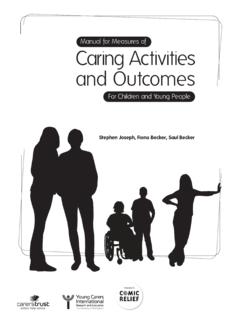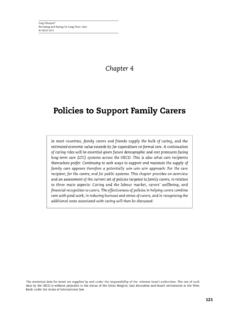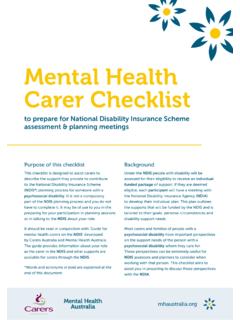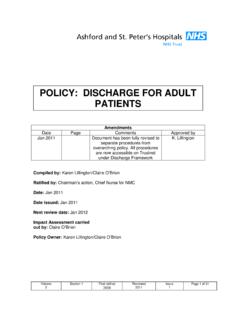Transcription of The impact of pulmonary arterial hypertension (PAH) on the ...
1 THE impact OF pulmonary arterial hypertension (PAH) ON THE LIVES OF PATIENTS AND carers : RESULTS FROM AN INTERNATIONAL SURVEY1 The impact of pulmonary arterial hypertension (PAH) on the lives of patients and carers : results from an international surveyThis large scale PAH Patient and Carer Survey was carried out to provide new insights into the wider impact of PAH on patients and carers beyond the clinical definition of the physical burden of the disease, which until now, has not been extensively researched. It explores four main areas: the physical and practical impact of PAH; the emotional impact ; the financial impact ; and information needs and provision; to better understand PAH patients and carers experience of living with the disease and to inform research and provision of more comprehensive care in the survey provides an international perspective, with respondents from five countries in Europe: France, Germany, Italy, Spain and the UK, all with different healthcare systems.
2 For the first time, it explores the carer s perspective as well as the impact of PAH on patients.* Generally, the findings across the countries were consistent and reveal not only the major limitations that PAH has on the ability of patients to carry out everyday activities however small, such as household chores, shopping for food or taking a shower, but also the financial impact due to limitations on the ability of patients and carers to work. Last but not least, the results highlight the social isolation that the disease causes, especially among family and friends. The survey shows that a decline in patients functional class (FC) (a classification of severity of the condition, with FC I being the least decline in function and IV being the greatest) is associated with a greater impact on a wide range of factors beyond just physical activities, including relationships, the ability to work and to socialise, and emotional from the carers survey underline the need to include them as stakeholders in all aspects of the management of PAH.
3 Most carers reported that caring for someone with PAH had had a very significant impact on their lives, and one in three had seen a reduction in their income, largely due to having to give up work or changing their working hours to take on a caring the steering committee of PAH specialists and representatives of patient organisations that led the development of the survey and this report, we hope that these important findings will help healthcare professionals and patient organisations to take account of the broader impact of PAH on patients and carers beyond the current definition of clinical symptoms and to provide care that meets these : Our thanks to the PAH patients and carers who took part in the surveys and to the Associazione Ipertensione Polmonare Italiana Onlus (AIPI), Associazione Malati di Ipertensione Polmonare (AMIP ), Asociaci n Nacional de Hipertensi n Pulmonar (ANHP), Association des Scl rodermiques de France (ASF), Fundaci n Contra la Hipertensi n Pulmonar (FCHP), HTAP France, PHA UK, Pulmonale hypertonie who gave valuable input into the planning and recruitment of this research.
4 * A selection of questions asked during the survey can be found throughout this report Dr Luke Howard Consultant Chest Physician, Imperial College, UKSandra Lombardi Specialist Nurse, UCSD Medical Center, USAH enrik Ryftenius PAH Specialist Nurse, Karolinska University Hospital, Sweden Dr Sean Studer Medical Director of Lung Transplantation and Director of pulmonary hypertension ,Newark Beth Israel Medical Center, USA (Co-chair)IRino Aldrighetti President, pulmonary hypertension Association, USA Iain Armstrong Chairman, pulmonary hypertension Association, UKPisana Ferrari Vice President, pulmonary hypertension Association (PHA) Europe, ItalyAryeh Fischer, MDActing Chief, Division of RheumatologyCo-Director, Autoimmune Lung CenterNational Jewish Health, Denver, ColoradoProf Loic Guillevin Professor of Internal Medicine, H pital Cochin, France (Co-chair)THE impact OF pulmonary arterial hypertension (PAH) ON THE LIVES OF PATIENTS AND carers : RESULTS FROM AN INTERNATIONAL SURVEY54 Illustration 1.
5 PAH: histopathological fibrosisDirection of blood flowIntimal and medial thickeningNormalIntimaEndotheliumMedia and smooth muscleAdventitiaEndothelial proliferationIntimal fibrosisMedial and smooth muscle cell hypertrophyCollateral fluxPlexifom lesionIntimal fibrosis and in situ thrombosisIntimal fibrosisIn situ thrombosis2211It totally changes your life - you can t ignore it because it will worsen and beat you until you re unable even to turn and move a pillow. Your body is weak, you have to pace yourself so as not to use precious energy. PatientWHAT IS PAH? pulmonary arterial hypertension (PAH) is a progressive disease caused by narrowing and tightening (constriction) of the pulmonary arteries, which connect the right side of the heart to the lungs. By definition, PAH is characterised by an increase in mean pulmonary arterial pressure (PAP) to at least 25 mmHg at rest, and a mean pulmonary capillary wedge pressure (PCWP) of <15 , 2 As PAH develops, blood flow through the pulmonary arteries is restricted and the right side of the heart becomes enlarged due to the increased strain of pumping blood through the lungs.
6 It is this strain on the heart and the decrease in blood to the left heart and systemic circulation through the lungs that leads to the common symptoms of PAH, such as breathlessness, fatigue, weakness, angina, syncope, and abdominal Although there is no cure, treatment is aimed at improving symptoms, exercise tolerance, long-term outcomes and quality of life. Until the mid-1980s there were limited treatment options for patients and PAH was associated with poor COMMON IS PAH?Although PAH is a rare disease, with an overall estimated prevalence of 15-50 cases per million3, the prevalence of PAH is substantially higher in certain at-risk groups, including patients with human immunodeficiency virus (HIV) infection and those with systemic sclerosis. WHAT CAUSES PAH?One of the more common forms of PAH is idiopathic PAH (IPAH), which is a sporadic disease in which there is neither a family history of PAH nor an identified risk Heritable PAH (HPAH) accounts for at least 6% of cases of PAH5 and mutations in the bone morphogenetic protein receptor 2 (BMPR2) have been identified in the majority of PAH can also be caused by the use of certain anorexigenic agents, such as ,7 However, the incidence of drug-induced PAH related to fenfluramine is decreasing since this agent is no longer available.
7 PAH can also be associated with a number of other conditions (associated PAH, APAH), which together account for most other cases. These conditions include: connective tissue disease; HIV infection; portal hypertension ; congenital heart disease; schistosomiasis and sickle cell IS THE impact OF PAH ON PATIENTS?Changes to the pulmonary vasculature lead to the typical symptoms of PAH, which include: breathlessness (dyspnoea), particularly during physical activity; fatigue; dizziness; syncope, also on physical activity; peripheral oedema and chest pain, again, particularly during physical , 7, 8 These symptoms can severely impact a patient s ability to carry out normal daily activities. As the disease progresses, some patients may experience constant dyspnoea and fatigue so that even simple tasks, such as getting dressed and walking short distances, become clinical severity of PAH is classified using a system that grades PAH severity according to the functional status of thepatient, linking symptoms with activity It allows clinicians to quickly and accurately assess disease progression and prognosis, as well as the need for specific treatment regimens, irrespective of the underlying aetiology of PAH (Table 1).
8 The impact of pulmonary arterial hypertension (PAH) on the lives of patients and carers : results from an international surveySeptember 2012 Sponsorship: The survey and report have been developed under the auspices of a steering committee of PAH specialists and representatives of PAH patients organisations supported by Actelion Pharmaceuticals Ltd, Switzerland. The market research agencies involved in the surveys were commissioned by SUMMARYBACKGROUNDP ulmonary arterial hypertension (PAH) is a rare condition but one which has a major impact on morbidity and mortality and currently there is no cure. There has previously been relatively limited research into the broader impact of PAH on the lives of patients and carers beyond the current definition of clinical symptoms, so an international self-reported survey using market research methodologies was carried out to explore this.
9 A multidisciplinary steering committee of PAH specialists, including respiratory physicians, internists, rheumatologists, PAH specialist nurses and patient group representatives, led the development of the survey content and analysis of results to ensure medical and practical total of 455 PAH patients (n=326) and carers (n=129) from five European countries (France, Germany, Italy, Spain and the UK) replied to questionnaires asking about four main areas: the physical and practical impact of PAH; the emotional impact ; the social impact ; and information needs and provision. This quantitative data was informed by qualitative interviews with 25 PAH patients and 15 carers to provide information on key themes to further explore in the online/postal FINDINGSMore than half (56%) of patients and a similar proportion of carers (57%) said PAH had a significant impact on their daily life, which was associated with decline in functional class (FC).
10 Employment/work and income emerged as areas of particular concern for both patients and carers : 85% of patients and 29% of carers said their work was affected by PAH. Nearly three-quarters (73%) of patients said their household income* was reduced by PAH, leaving most families with below average household incomes. Many patients reported that their sex lives were severely affected; as did carers who were partners of PAH patients. Over half (55%) of patients and one-third of carers reported feeling isolated, with a major reason being a lack of understanding of the disease among family and friends, as well as among the general public. The emotional impact on patients of having PAH included feelings of frustration (35% had felt this in the last month); feeling misunderstood; little pleasure in activities; anger and low 25% of carers felt stressed whilst caring for their relative and trying to meet their other responsibilities, which increased with decline in the patient s FC.







